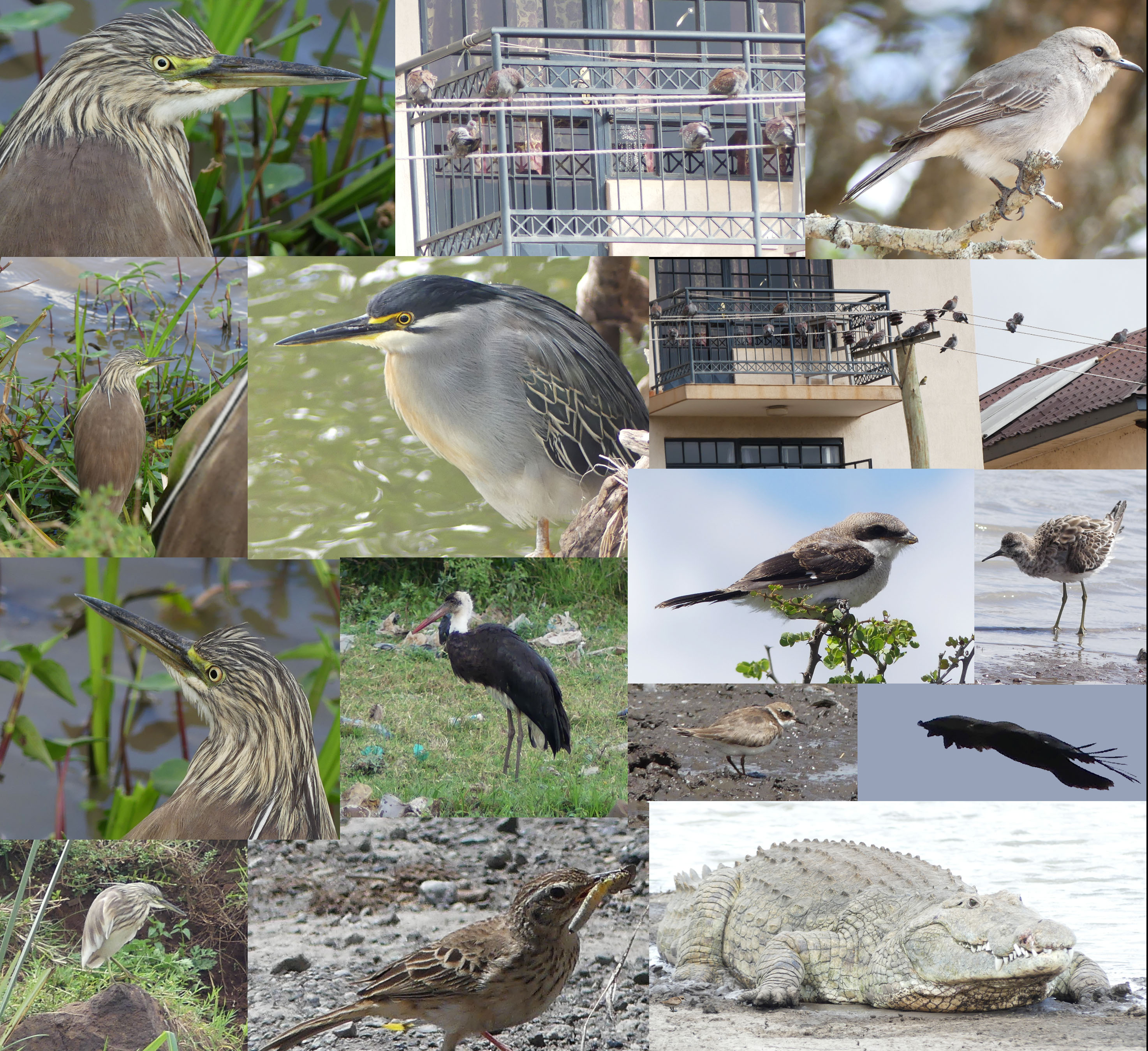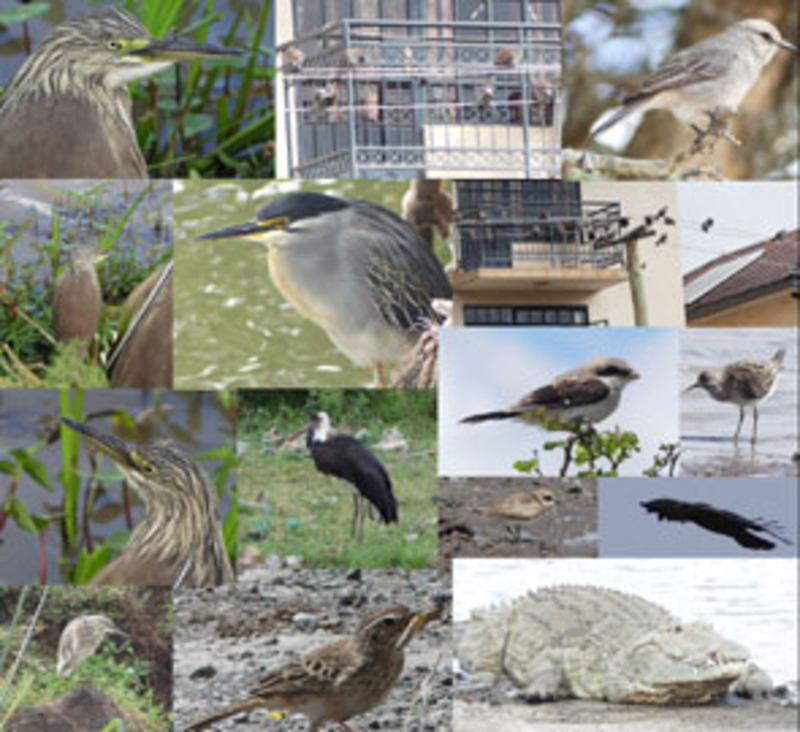From: Brian Finch <birdfinch@gmail.com>
Date: 2018-12-08 18:02
Subject: NAIROBI NATIONAL PARK 30th NOVEMBER 2018
NAIROBI NATIONAL PARK 30th NOVEMBER 2018
Dear All,
Nigel Hunter and I arrived at Main Gate at 6.40am, there was no queue
and we were through the entrance into Nairobi National Park before
7.00am.
It was dark and overcast, no rain but a strong wind. The wind
persisted until early afternoon and made observation difficult and it
kept the air temperature uncomfortably cool.
We first made for Ivory Burning Site, the most prominent bird was
Olive Thrush there were droves attracted by the Rus fruits. The
numbers were very large, and they were accompanied by Bulbuls and a
few Blackcaps. Apart from a couple of Garden Warblers and Nightingales
no other migrants were seen at the place until four Eurasian Golden
Orioles flew in. An immature Great Sparrowhawk stirred things up a
bit. Nagalomon Dam was silent and birds were not moving in the bushes
apart from a few Blue-naped Mousebirds, on the dam there were a couple
of African Spoonbills, Great Egret, a few Long-tailed Cormorants and
three Darters, a few Black-winged Stilts, two Green Sandpipers and
three Pied Kingfishers and that was it. Along the back road to Hyena
Dam there was a very obliging Sprosser feeding in the middle of the
road quite unconcernedly, but apart from calling Garden Warblers no
other migrants and no other species of migrant warblers were found all
day.
At the apartments further along the road was an extraordinary sight.
Usually there are two or three Speckled Pigeons on the water tank, but
today the was a gathering of 32 on a third floor balcony where they
were obviously getting handouts. (See image). Numerous Speke’s Weavers
and a few Red-billed Queleas were also feeding.
Hyena Dam was none too exciting, the only second species of waterfowl
was one Red-billed Teal, but on the causeway we found a Squacco Heron,
this was a very stripy necked bird and looked like the bird seen very
briefly several weeks ago which was thought a potential for being a
Pond Heron, (see images and discussion). The first of just two Augur
Buzzards was here, ten Black-winged Stilts, six Long-toed Plovers, two
Green, thirty Wood and two Common Sandpipers, and two Ruffs were
around the edges. In the bushes was the first of five Whinchats, and
the days only Yellow Wagtail looked like an immature lutea.
We took the run-off road but apart from a few Quail-Finch and a flock
of over fifty Parasitic Weavers many of which were males in breeding
plumage, there was little to see. Circling back round an passing
Nagalomon Dam again we had a Saddle-billed Stork, three Crowned Cranes
and a Steppe Eagle below Impala Lookout, the only Black-shouldered
Kite of the day, the was an African Water Rail at the Kingfisher
swamp, and the first of four Isabelline Wheatears. The old burnt area
provided the first of four Northern and the first of five Pied
Wheatears but nothing else.
Our next stop was down to the Mbagathi River at Ololo, the riverine
gave us a dozen species we had not so far recorded today, and it was
completely sheltered with Red-faced Cisticola, the first of four
Spotted Flycatchers a Yellow Bishop in non-breeding and two
Black-faced Waxbills. Towards Leopard Cliffs were a few Eurasian
Bee-eaters, and at the Mokoyeti crossing below Baboon Cliffs was a
stunning adult Striated Heron (see image), and the Pallid Honeyguide
was singing from his favourite tree.
Above Hippo Pools were a nice Long-billed Pipit (see image), an
African Hoopoe and a few Speckle-fronted Weavers but no migrants were
encountered, the ox-bow was drying fast and had a Yellow-billed Stork,
the only African Fish Eagle the whole day, a couple of Black-winged
Stilts, Marsh, Green Wood (3) and Common Sandpipers (2) whilst Rhino
Circuit drew a blank apart from two Violet Wood-hoopoes and a
Grey-headed Kingfisher in the usual spot.
Athi Dam fared badly as well, one each of Yellow-billed and
Open-billed Storks, forty Marabous, three African Spoonbills, an adult
and a rather pallid looking immature Ringed Plover (see image), three
Kittlitz’s Plover, four Little Stint, a Ruff and a Reeve with
strange-coloured olive-green legs (see image), one each of Marsh and
Green, eight Wood and two Common Sandpipers, four Common Greenshank
and five Black-winged Stilts. Three Black-crowned Night-Herons roosted
on the causeway where there was a Banded Parisoma.
On the return with the wind abated, a Yellow-billed Egret at the
Empakasi Dam junction, three White-bellied Bustards in the grassland,
on Langata Dam was a Little Grebe and a good congregation of drinking
Blackcaps, and finally bird of the day was on the Langata Gate Vlei
where whilst apparently staring out at nothing, a Woolly-necked Stork
walked out of the wild Asters and paraded in the open. This is the
first reported in this part of Nairobi for many years. (See image).
We were through the gate at 5.30pm. It had been an annoyingly gloomy
and windy day, but whilst migrants were so disappointing we had
recorded 178 species.
Best to all
Brian
KEY TO MONTAGE
1 SQUACCO HERON
This is almost certainly the same bird seen very badly nearly a month
ago in the back swampy inlet of Hyena Dam, when it was thought
possibly a candidate for an Indian Pond Heron. It was good to have
closure rather than wondering about the bird, but in spite of looking
unusual it is positively a Squacco Heron. The protruding head plumes
now visible on the bird are white with narrow black edges (see inset);
Squacco Heron is the only member in the genus of five species to not
have entirely white head plumes. As can be seen from the bottom left
image it is a very heavily broadly streaked bird.
2 SPECKLED PIGEONS
Invading the balcony of the apartments. I have never come across them
behaving like this before. The odd bird used to come in to the Lake
Baringo bird-table but not more than two.
3 GREY FLYCATCHER
It was posing so nicely I could not resist it.
4 STRIATED HERON
A beautiful adult below Baboon Cliffs.
5 LONG-TAILED FISCAL
As there were no migrant shrikes of any kind today, we studied this
really attractive young Long-tail which was equally attractive and
looked like a
Migrant shrike!
6 REEVE
At Athi Dam, with strange olive-green legs.
7 WOOLLY-NECKED STORK
An adult amongst the rubbish that comes into the vlei every time there
is heavy rain.
8 COMMON RINGED PLOVER
Seen at a distance this pallid bird with what looked like a rusty
tinge to the crown and a narrow white band encircling the neck looked
interesting. Disappointment came when we saw the yellow legs!
9 STEPPE EAGLE
A poor image as it was so gloomy, just here to fill in an empty space.
10 LONG-BILLED PIPIT
Eating an insect that I haven’t sorted out yet.
11 NILE CROCODILE
The Athi Dam Emperor out on his throne.





